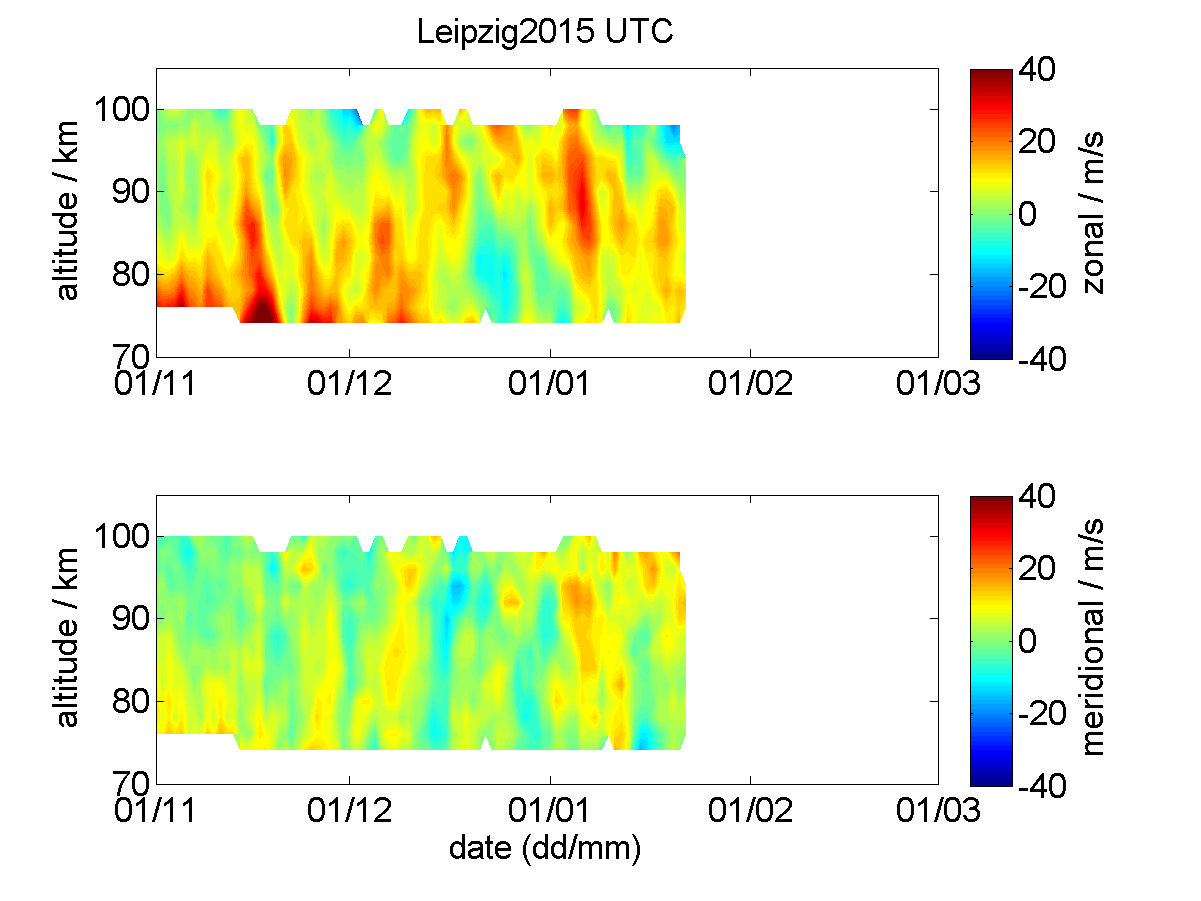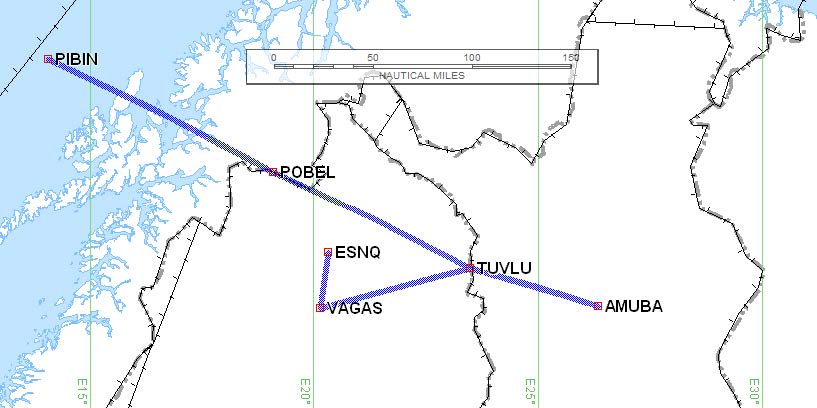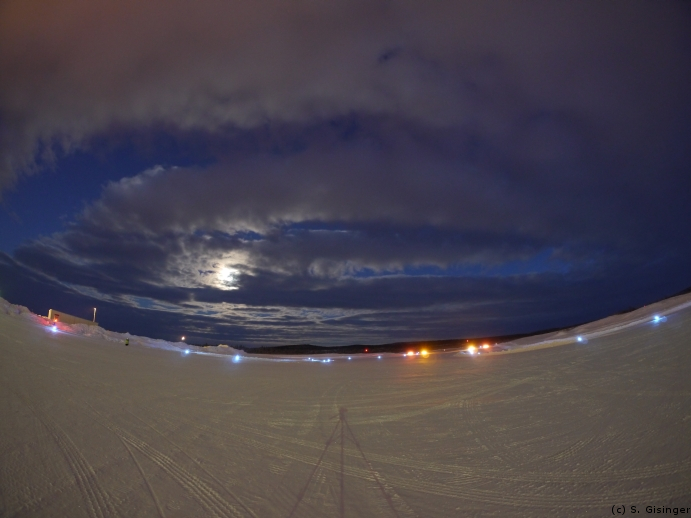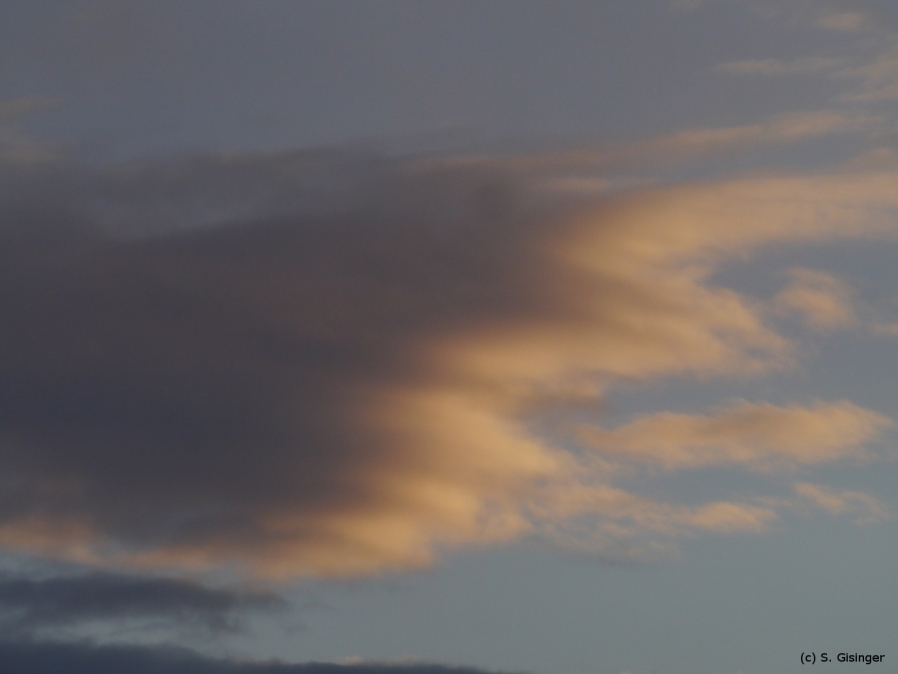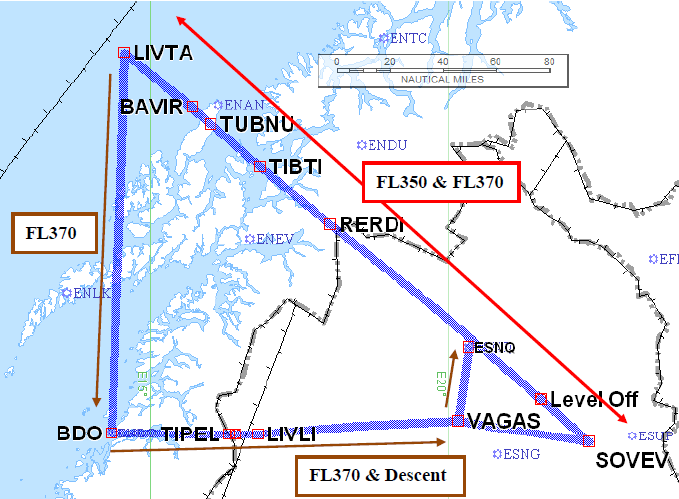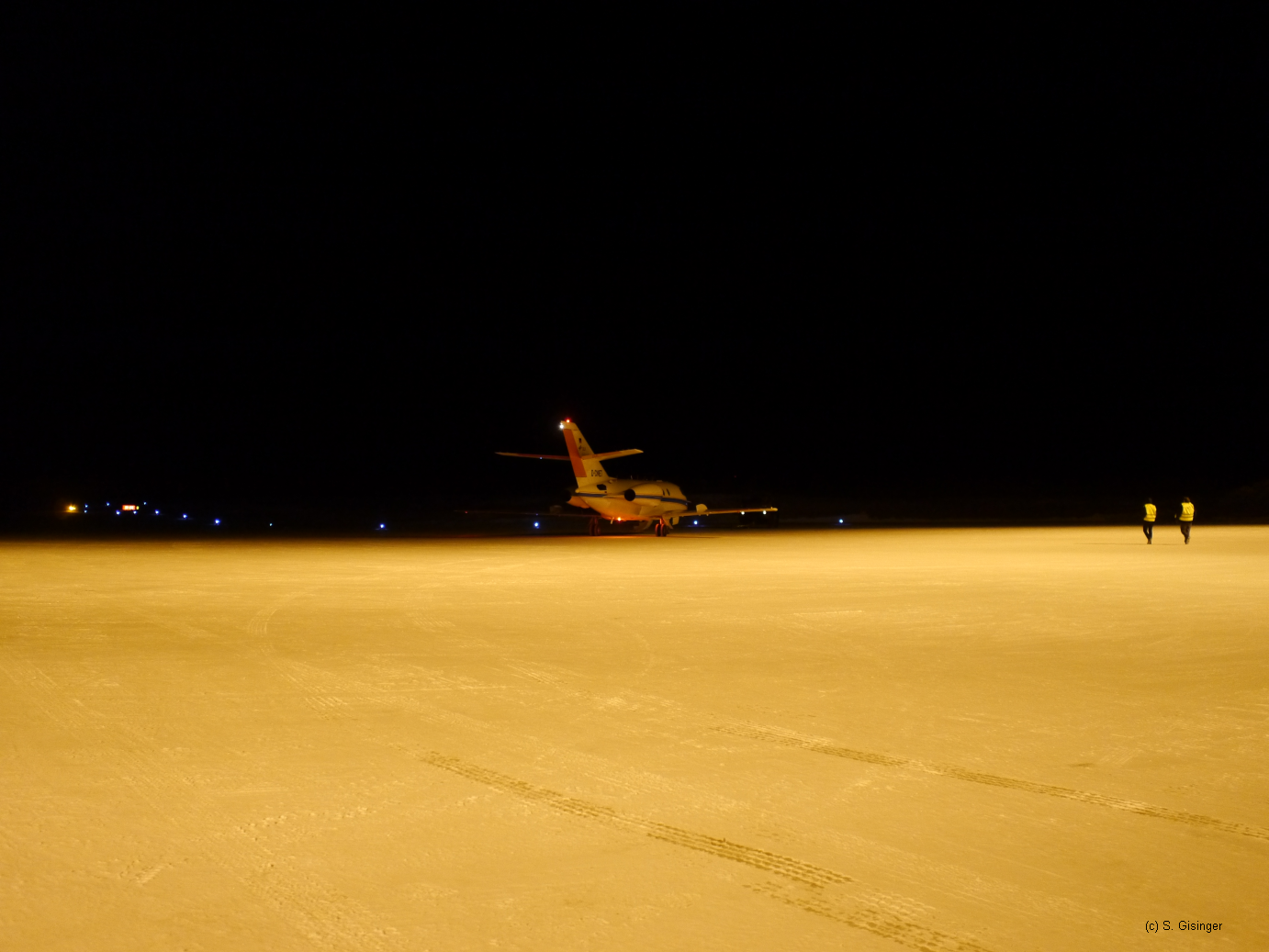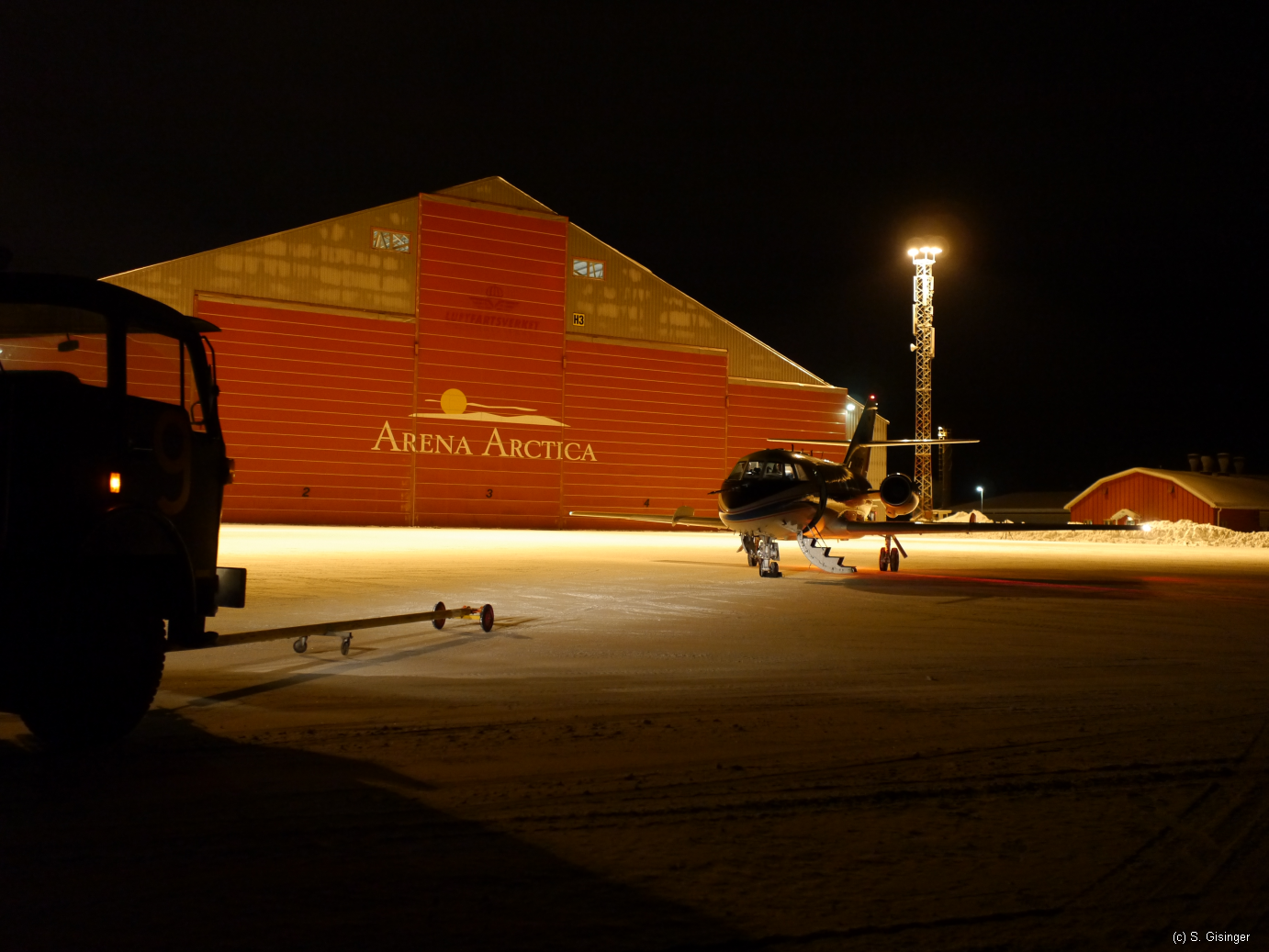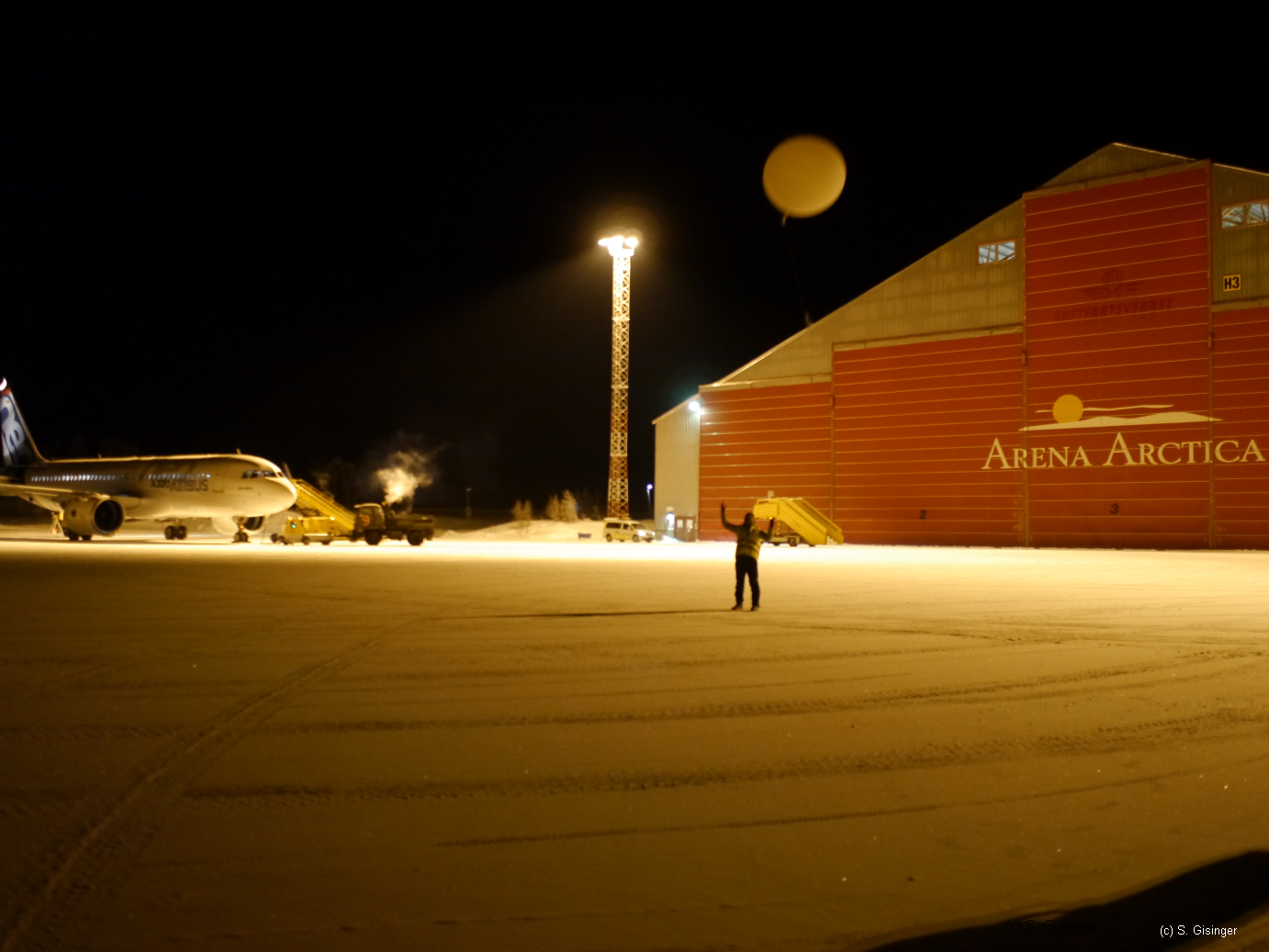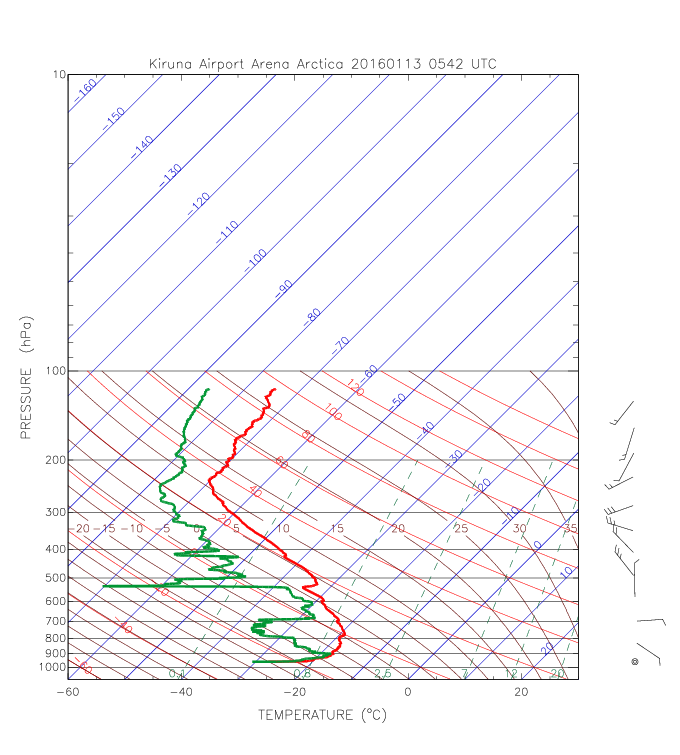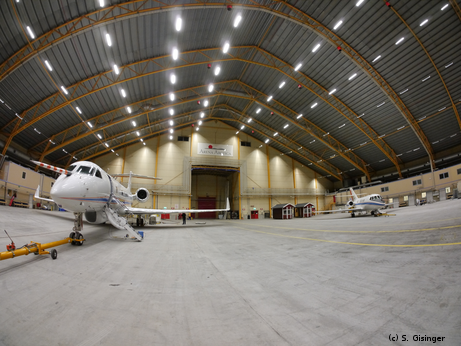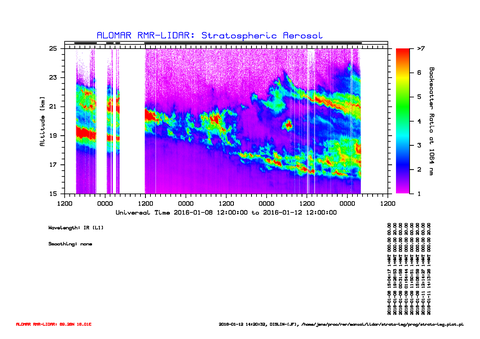Field Campaign - GWLCYCLE 2 - Scandinavia 2016
Home | Instruments | News | Forecasts | Quicklooks | Gallery | Contact | Links | Intern
February 3rd, 2016 - Falcon back in Oberpfaffenhofen
sg - The Falcon and the crew are safely back in Oberpfaffenhofen. This means the end of the airborne measurments of the GW-LCYCLE 2 campaign. Most of us are already on their way back or will be tomorrow. Ground based lidar measurements in Anodya, Esrange and Sodankylä are going to continue for some more weeks. HALO is going to stay in Kiruna until 23rd of February when the third and last phase of the POLSTRACC campaign is going to take place for 4 more weeks.
January 30th, 2016 - LITOS balloon launch at Arena Arctica
Colleagues of the IAP Kuehlungsborn came to Arena Arctica to launch their LITOS turbulence measurement balloons.
They were not able to launch their balloons from Andoya Rocket Range anymore due to restrictions of the Norwegian ATC considering
launching times and dropping region when the balloon bursts. Moreover, gusty and snowfall conditions may also could have impeded
the launch (examples of launches under such conditions can be seen in the videos linked further below on this page).
Unfortunately, parts of the equipment did not get through customs at the Swedish border. From two cars with 4 people and lots of equipment
only one car with 4 people and still lots of equipment made its way to Kiruna. Launching conditions were perfect on
Jan 29th at Arena Arctica. Nevertheless, some abnormality occured. But see for yourself (tip: turn sound on ;-) ):
Impressum / Imprint - Datenschutzerklärung / Privacy Policy
January 28th, 2016 - Group photo with HALO and FALCON
January 28th, 2016 - Articles on DLR Newspage (in German)
January 28th, 2016 - Summary 4th Falcon flight on 20th January
ph - During the fourth Falon flight on 20th of January 2016 a tropopause fold was crossed on four levels. The goal was to identify particularly irreversible downward transport of stratospheric air associated with the fold. The fold structure was probed by drop sondes, which were released by the HALO aircraft close to the operational area of the Falcon. Precise measurement of N2O on board the Falcon aircraft provide a method to identify stratospheric air by N2O values, which are below tropospheric mixing ratios. Since N2O has no tropospheric chemical or microphysical sink, these values unambigously indicate a stratospheric contribution of air. First results indicate a high variability of N2O (as well as other tracers) on the three upper flight levels and stratospheric entrainment of stratospheric air into the troposphere on small scales at FL 270 (~8 km). Comparison with the turbulence measurement of the Falcon will provide further information if the high variability is linked to non-conservative processes and mixing.
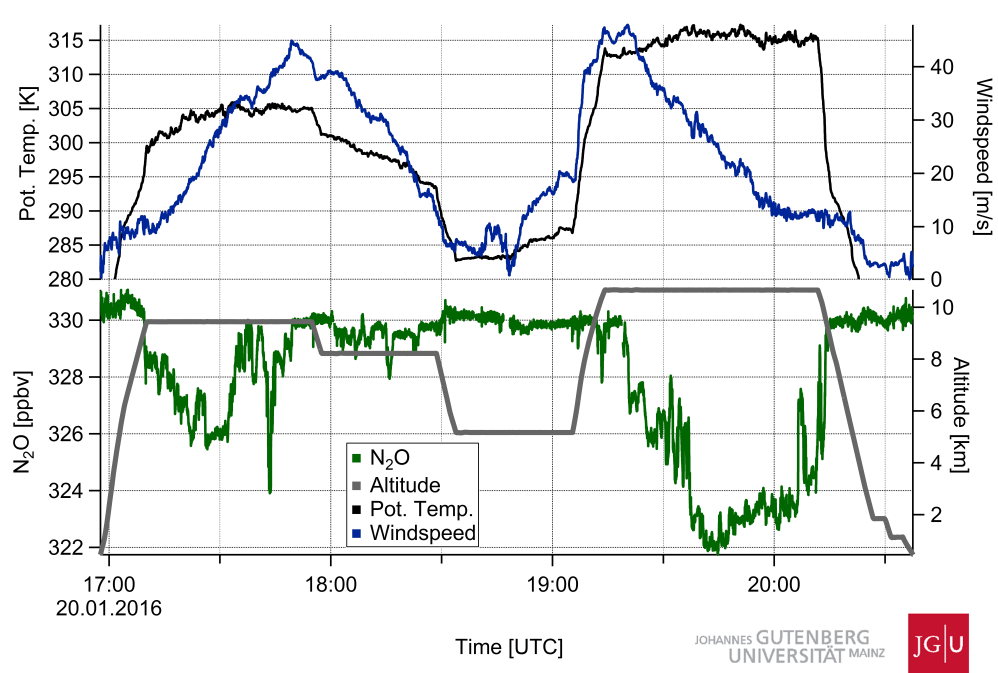
Windspeed and potential temperature as measured from the Falcon aircraft (top) and
flight altitude and preliminary N2O (bottom) along the flight track. N2O
levels below 329.5 ppbv are indicative for stratospheric air.
January 24th, 2016 - Fly(ing) scientists
ms,rs,sg -Yesterday, legs of a stowaway were found in the pipe of the water vapour measurement device on the Falcon. Further investigations revealed the remaining parts of the fly. Today, during maintenance of the other instruments another fly was found in a tube. This one was still alive searching its way towards the mass spectrometer. Although this campaign takes place under cold weather conditions, these flys still find a place to survive in the warm hangar. And it seems they are attracted by the inlets on the aircraft. ;-)
January 23rd, 2016 - Update on mesospheric winds
gs - Update of the mesospheric wind situation above Andenes und Leipzig. This winter seems to be very different from a typical mesospheric winter situation. After the mesospheric zonal wind reversal in December 2015, a rather stable wind pattern above Andenes established. The zonal wind showed almost summer conditions with a negative zonal wind below 80-82 km altitude and a strong positive mesospheric zonal jet above. However, more interesting is the situation above Leipzig (mid-latitudes). There, we had so far a typical winter conditions dominated by a strong planetary wave activity. Over the last days, the data indicates a wind reversal above 95 km altitude in the zonal wind. At present, it is too early to consider this as a potential upcoming SSW event, although we expect a stronger signal of the SSW at mid-latitudes due to the displacement of the polar vortex.
January 23rd, 2016 - Launching conditions Andoya for LITOS on 22nd Jan
Due to gusty winds in Andoya the launch of the LITOS balloon was challenging and needed two attempts. Videos of Gerd can be found here (first attempt) and here (start). Another interesting balloon launch under icy conditions can be found here.
January 22nd, 2016 - First Falcon Mountain Wave flight completed
sg,ad - Today the Falcon conducted the first research flight during meteorological conditions triggering mountain waves. All instruments worked well during the flight. The airborne measurements were complemented with 3-hourly radiosoundings from Arena Arctica, as well as with ground based lidar measurements whenever the surface stations were free of clouds. In addtion high resolution balloneborne turbulence measurements (LITOS) were conduted by IAP Kuehlungsborn from Andoya. The weak westerly flow over the northern part of Scandinavia lead to at least some nice wave clouds over Kiruna. The Falcon measurements must be further analyzed to quantify the amount of wave activity.
January 20, 2016 - MODES analyses and forecasts available for GW-LCYCLE
ad - Nedjeljka Žagar, Blaž Jesenko, and Damjan Jelić provide northern hemispheric polar plots via their MODES web page for GW-LCYCLE flight planning and analysis. MODES rotational and internal gravity wave fields allow to visualize the balanced and unbalanced components of the atmospheric wind field. More about the modal analysis of atmospheric circulations can be found on Nedjeljkas web page. Thanks to the MODES team in Ljubljana!
January 18th, 2016 - Third Falcon flight completed: coordinated measurements with ground stations
ad,cs - Our third research flight was devoted to three objective: to observe mesospheric gravity waves inside the polar vortex under without orographic forcing by FAIM-02, the airborne airglow camera by Carsten and Patrick. Secondly, to observe the dynamical and chemical structure of Arctic stratospheric air (far away from active weather systems) by in-situ flight level instrumentation, and, finally, to compare airborne observations with with ground-based instruments (MAARSY, AMTMs, Lidars).

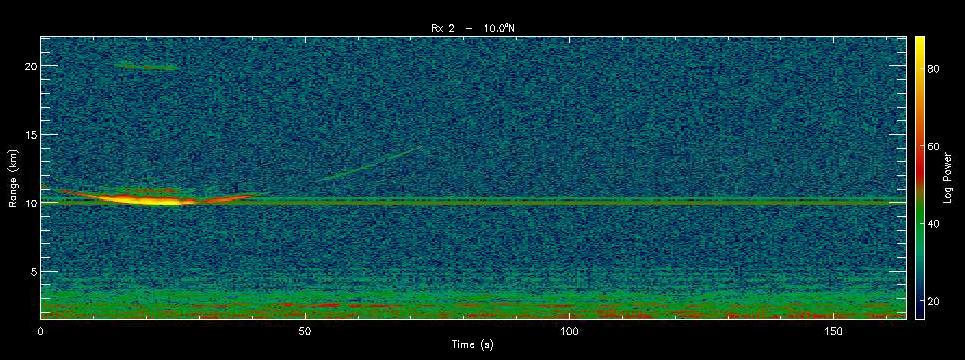
Radarecho of the Falcon in MAARSY data. With some imagination you can also see the nose boom.
January 17th, 2016 - Update of Planetary wave analysis
vm,ad - The recent MLS planetary wave analysis by Vivien showed that the amplitude of wave number 1 decreased, the maximum area is contracted in latitude and extended in altitude. The stratopause ascended in altitude and, as Gerd remarked, the stratopause had up to 292 K, unusually high temperatures considering the stratopause haven't descended.
January 17th, 2016 - Video of RMR lidar operation at ALOMAR
nk - A beautiful video with lidar beams, stars, meteors, light pillars from Gerd: watch video
January 15th, 2016 - Second Falcon flight completed
ar - Today, the Falcon undertook a flight devoted to our secondary objectives: to explore the emissions of off-shore oil and gas exploration facilities. The Greenhouse gas emissions of these facilities are not well known and very few independent measurements are available. On 15 January 2016, the DLR Falcon conducted measurements in the Norwegian Sea area off the Norwegian coast, where currently 14 off-shore oil/gas fields in total are actively exploited. The objective of this mission was to sample greenhouse gas emissions (CO2 and CH4) released by oil/gas production facilities to better quantify related emissions. The Falcon measurements were carried out in cooperation with the Statoil company and focused on observations downstream of three of the largest platforms in that area, the Asgard A facility (oil production), the Asgard B installation (natural gas production), and the Heidrun platform (oil/gas production). Plume samples were taken in the boundary layer at several km“s downstream of the facilities and at different flight levels (down to about 150 m).
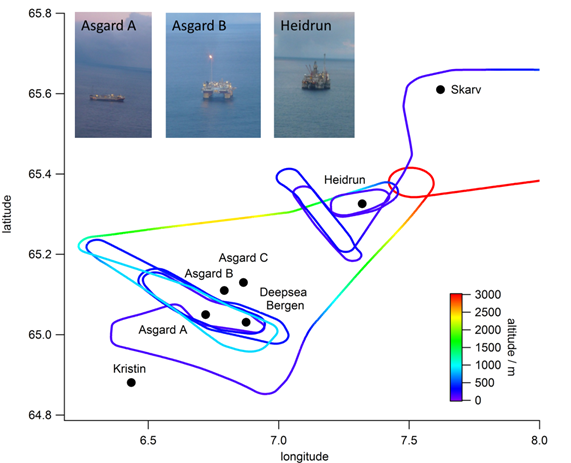
January 14th, 2016 - First Falcon flight completed
sg - Today a Falcon flight was conducted between 1700 and 2000 local time. The flight
consisted of three legs over Kiruna and Andenes. The main goal of the flight was to test all
the instruments and to get coordinated measurments between the airborn OH-imager on the
Falcon and the ground based OH-imager and lidars located in Kiruna and Andenes. The
OH-imagers measure OH-emission in the airglow layer at around 80 to 87 km altitude.
Undulations of the airglow layer caused by gravity waves can be measured and allow to study
gravity wave properties.
The Falcon did not ascend to FL370 as it was planed but stayed on FL350 due to temperatures
below -70°Celsius above FL350. Those cold temperatures were and still are observed by the
radiosondes. The evening sounding reached nearly 18 km altitude when the balloon burst in an
ambient temperature of -82°Celsius.
bw - Among others, the flight included three overflights of the Alomar observatory. It was our first attempt to compare the airborne 2µ wind lidar and MAARSY wind profiles. The overflights were at 16:53:15 UTC, 17:07:05 UTC and 18:06:24 UTC about 12 km south-west (62.218°N, 15.846°E) of the MAARSY radar location (69.30°N, 16.04°E). Considering the flight altitude of about 9.9 km an overlap from about 5 km to 9.5 km between both instruments is obtained. Except for the overflight at 18:06 UTC, the wind difference between lidar and radar is less than 1 m/s. The difference in wind direction is less than 10°.
January 13th, 2016 - Regular radiosoundings Arena Arctica
sg - The first radiosoundings from Arena Arctica were conducted. Unfortunately the desired altitudes
of more the 30 km were not reached. The balloons already burst below 20 km altitude. This is most
likely caused by the extrem cold temperatures below -70°Celsius above the tropopause at the moment.
From now on we try to provide
Skew-T-logP diagrams shortly after a sounding is completed. They will be found in the Quicklook selection.
January 13th, 2016 - Temperature inside the container on the way to Kiruna
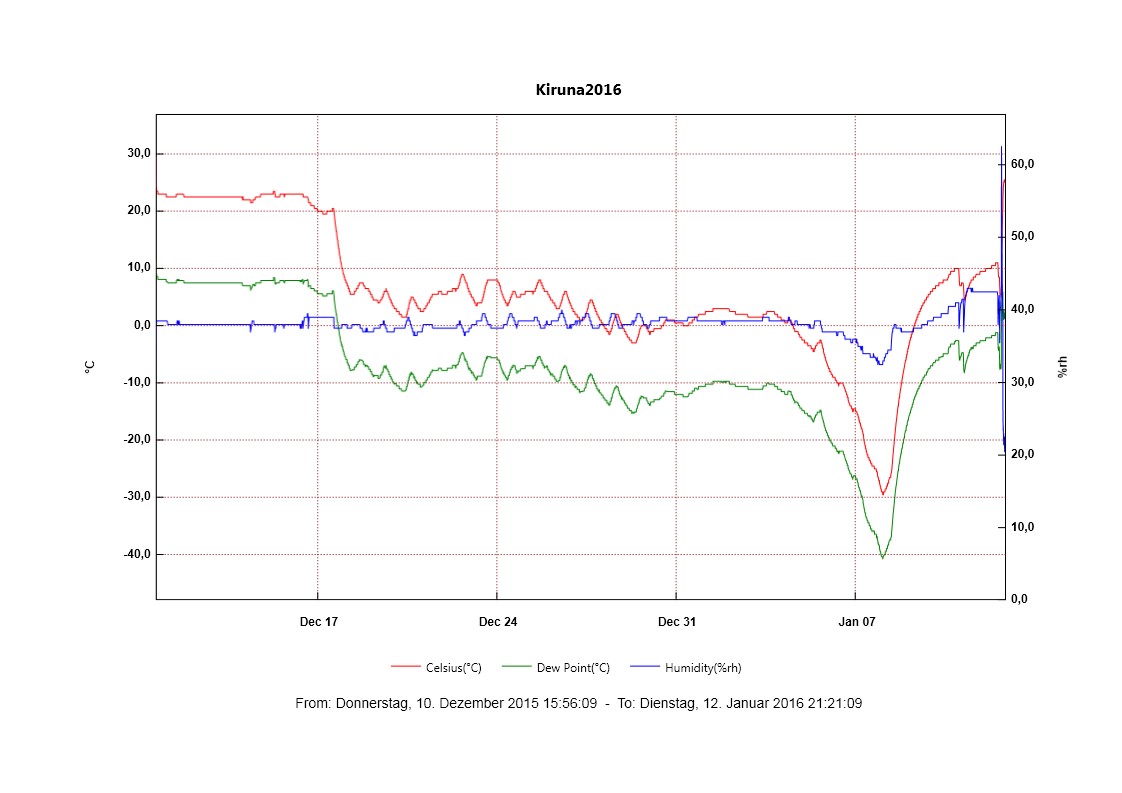
January 13th, 2016 - Radar winds over Andenes and MLS wave analysis
gs,vm - The viewgraph below shows daily mean mesospheric zonal and
meridional winds (tides are removed) from the meteo radar in Andenes. The
plot starts on 1st November 2015 and shows how a planetary wave evolving
until mid-December 2015 leading to a mini SSW (zonal wind reversal) in
the mesosphere. However, the zonal wind reversal is only weak. The second
half of December is characterized by the descend of wind reversal down
to an altitude of around 80 km. Since January 2016 the wind mesospheric
pattern looks more like a summer profile showing negative wind speeds
below 80-82 km and a strong positive zonal jet above 85 km altitude.
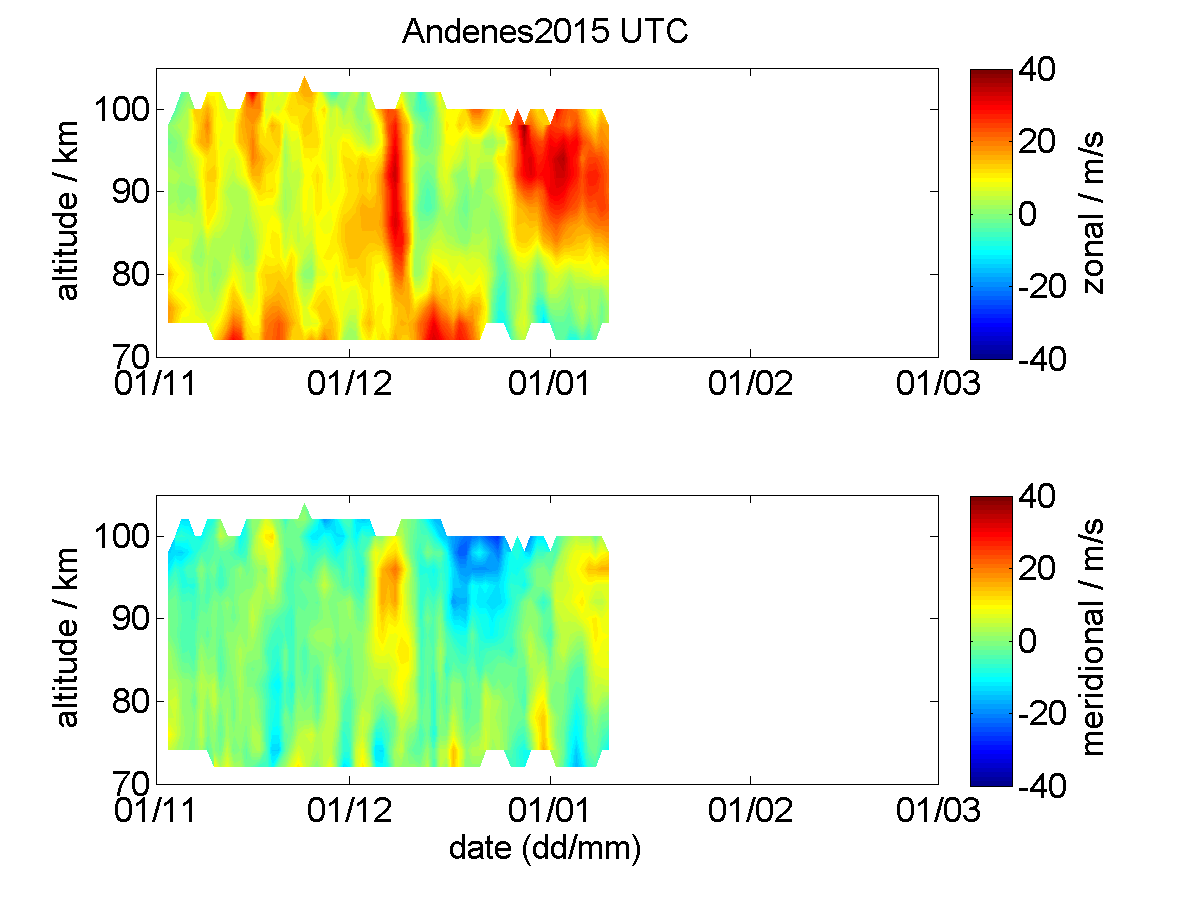
A MLS planetary
wave analysis shows the temporal development of MLS zonal mean
temperature from approximately 8 km to 97 km altitude (a). The stratopause
lightly descends at the beginning of January 2016. At the same time, the
wave 1 amplitude is very strong (see Figure b)) with a maximum around
65°N at 50 km (Figure c)). The wave 2 amplitude is vanishingly small
(Figure d)).
January 12th, 2016 - Falcon and HALO arrived
sg - Today the two research aircraft Falcon and HALO arrived at Kiruna
Airport. The Falcon made its way directly from Oberpfaffenhofen
to Kiruna and arrived at around 1300 local time. HALO first
moved southward to 35°N (Sicily) to cross the edge
of the polar vortex and a sharp edge of tropopause height (Geopotential at 2 PVU).
After a long transect from tropical air masses towards the core of the
polar vortex at 72°N, HALO landed in Kiruna at around 1745 local
time.
Regular radiosonde measurements from Arena Arctica at Kiruna
Airport will start tomorrow morning. Radiosonde will be released every
day at 0630 and 1830 local time. During meteorological situations
with mountain wave activity the frequency of sounding starts will be
increased.
The next days the flow situation is less
favourable for mountain waves over Scandinavia. A short period of
clear skys over Andoya and Kiruna on Thursday will probably be used to
compare the ground-based air glow measurements (OH emission at around
80 km altitude) with the air glow measurements of the camera on the
Falcon by conducting a short flight with overpasses over the ground
stations.
January 12th, 2016 - PSC at ALOMAR
nk - Almost four days of continuous PSC observation at ALOMAR, by the RMR lidar (below) as well as the iron lidar (plot)! Unfortunately, good weather conditions at ALOMAR usually means overcast sky at Sodankylä. The short CORAL observations however show no PSC in this period (PSC calendar). Right now (12 Dec 19 UT), PSCs are also back above Sodankylä.
January 11th, 2016 - Start of field campaign
nk - The first participants of the field campaign from IAP, MISU and DLR have arrived at their destinations: The three lidars at ALOMAR, Kiruna and Sodankylä are operated by Gerd, Marin and Stephanie; Michael and Sonja will start radiosondes at the Andøa rocket range and from Kiruna airport. HALO and Falcon will transfer to Kiruna tomorrow.
January 5th, 2016 - Unusual Cold Arctic Vortex
ad - The area of synoptic PSCs is unusually large this year compared to all other years before since 1991/1992!! Image courtesy by Peter von der Gathen (AWI Potsdam).
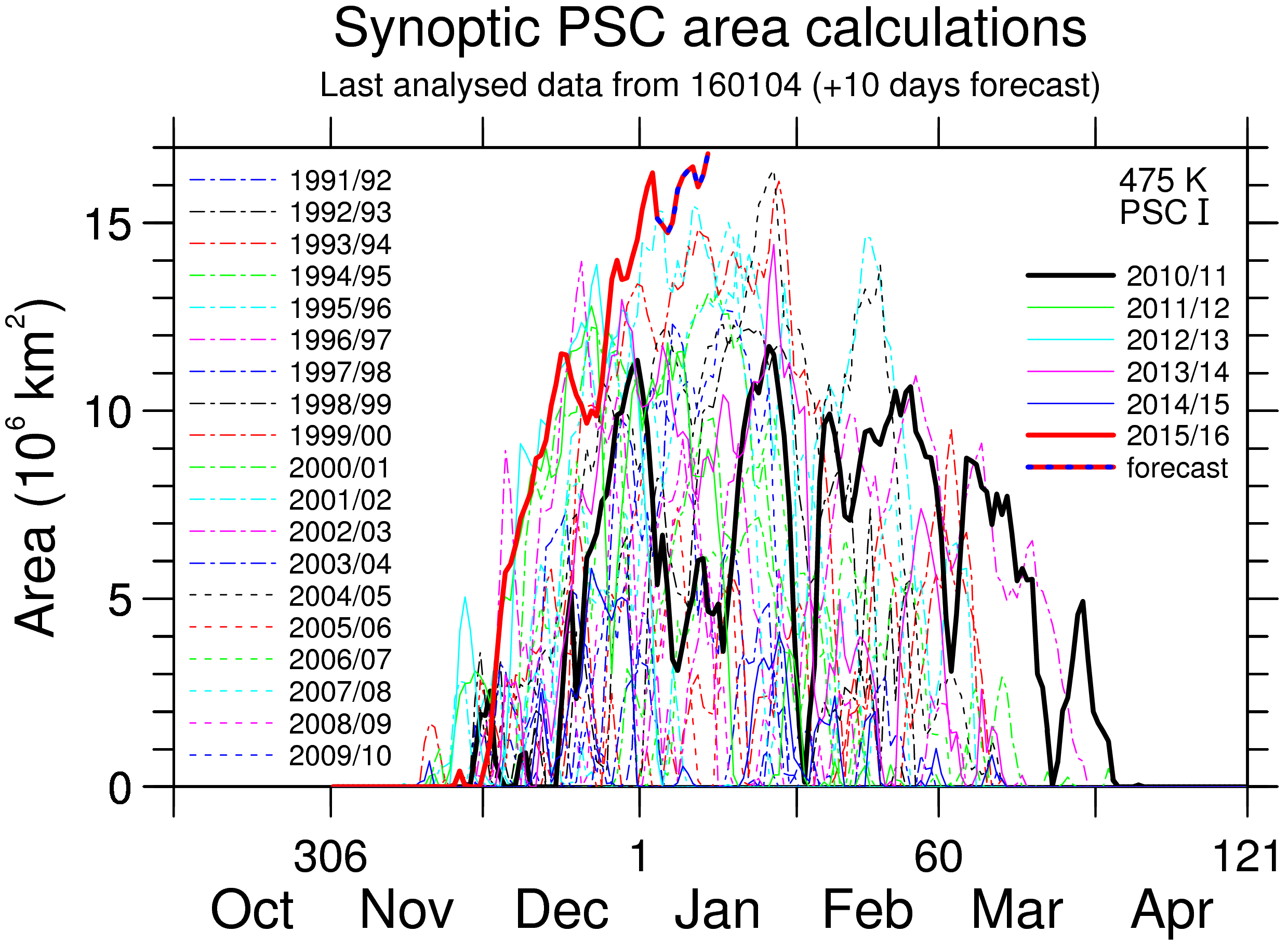
December 30th, 2015 - CORAL Statistics 2015
nk - At least we've seen an unusually warm stratopause in the preliminary data of the last days. The next few days however will be cloudy. During the last three months, CORAL has accumulated a total of 352 hours of atmospheric data, among them six measurements with more than 14 h length.
December 29th, 2015 - FAZ: Nun ist es ein Monstersturm
ad - Do we miss something between the years? FAZ Wissen.
December 26th, 2015 - FAZ: Der Polarwirbel hält nicht, was er verspricht
ad - Polar vortex in the media: FAZ Wissen.
December 17th, 2015 - Impressive photographs of polar stratospheric clouds
ad - Noctilucent Clouds over Tromsų: Photographs taken by Truls Tiller on December 16, 2015.
December 16th, 2015 - First polar stratospheric clouds
nk - Right now, there is PSCs visible in the lidar around 25 km. Visual observations from this morning comes from ALOMAR. Here are the ALOMAR livecams. We saw them for the first time this Monday, we think.
Quicklooks from the PSC retrieval can be found here.
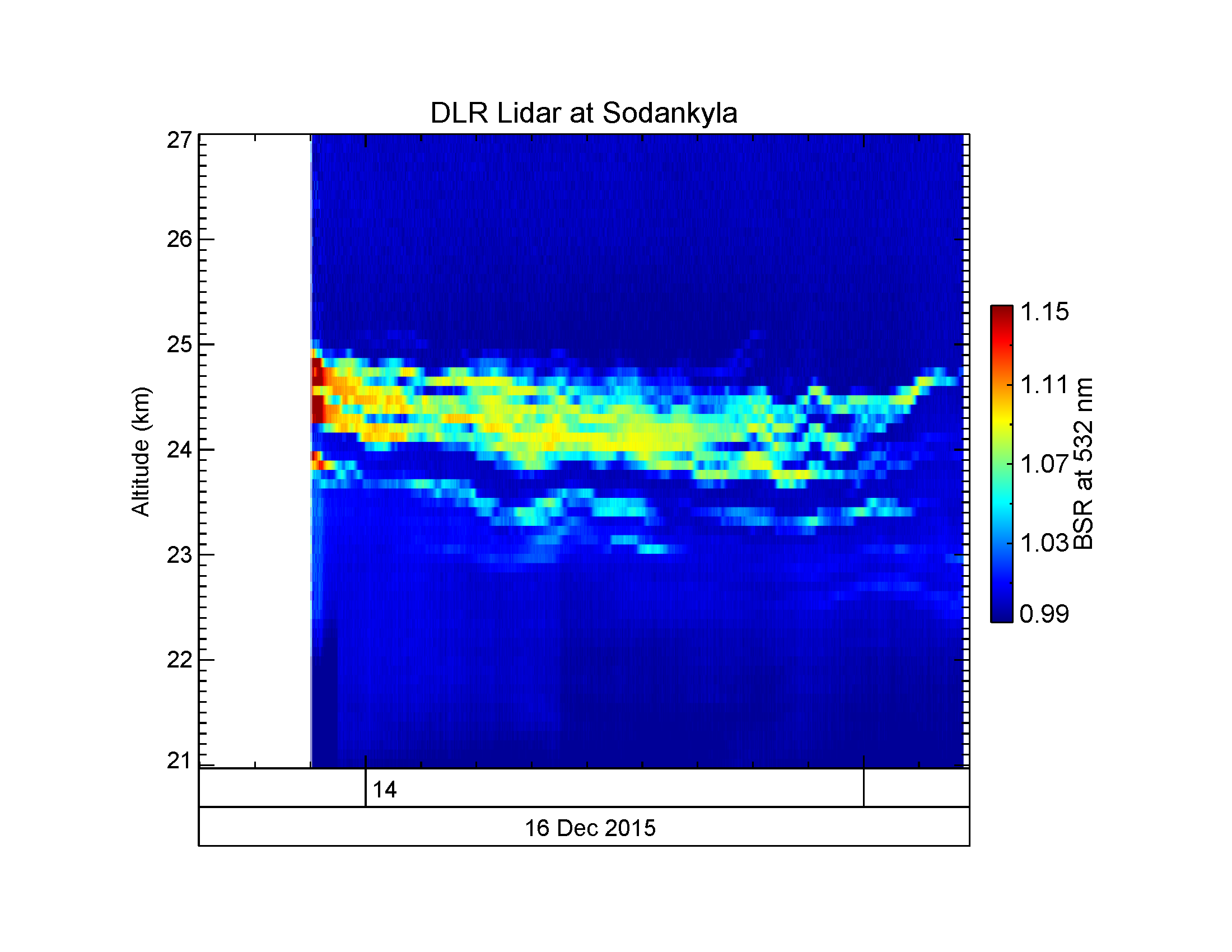
December 16th, 2015 - Fine weather
nk - Finally, the weather seems to be improving. Last night was 20 hours of measurement! The last four days were all above 10 h, too, and right now the lidar is active again. It is very impressive, however, how the temperature drops when the clouds go: from -4 deg to -28 deg celcius within maybe two hours. The lidar is operating at 22 deg. 50 K temperature difference, and everything working just fine. Good job, Bernd!
December 13th, 2015 - Record measurement
nk - The flight campaign is coming closer, with HALO performing first test flights for POLSTRACC this week. Last night, we had the longest lidar measurement so far of 14 hours, and stopped only due to twilight before restarting.
November 25nd, 2015 - Mysterious
nk - Strange things going on in Sodankylä! This is what we know: In the night between November 23rd to 24th, our allsky camera captured one last fine image on 21:44 UT, then it stopped grabbing with a timeout, although we didn't notice at the time. The lidar operated normally until 23:49 UT, when suddenly the microcontroller fell into safemode, turned off the laser and closed the hatches. Funnily, the AMTM, an independent system, stopped operation at the exact same minute. And then, when turning the system back on around midnight, a hole was burned into the CCD chip of our allsky camera. ???
Something exceptionally bright, I mean, many orders of magnitude brighter than the sun, tried to kill our camera in the middle of the night. Safe to assume it was the laser beam... But why? We spent yesterday collecting data from various instruments and logfiles in order to reconstruct the time and nature of the event.
Several ideas were dismissed. We hadn't hit a radiosonde, for example. We'll probably never find out, and after thinking all through, decided to resume measurements.
For now, the lidar and all other instruments are fine, the camera still useful, and its cloudy, more snow on the way. Total operation time of CORAL is about 150 hours now, and the AMTM is operating as well.
November 23nd, 2015 - Ready for winter
nk - Bernd finished preparations for winter and returned to OP on Saturday. Additional temperature sensors, heaters and heating cables were installed, glycol filled into the cooling circuit, safety algorithms implemented, and the mirror cleaned. Last night, the first measurement with -20 deg outside temperature were performed - more than 40 deg temperature difference between inside and outside!
Dominque has proceeded to Kiruna also on Saturday to install an AMTM there.
November 16nd, 2015 - Installation of AMTM at Sodankylä
nk - Bernd is at Sodankylä completing work on the CORAL lidar container. The dome for the new AMTM instrument is prepared. Dominique will arrive later today from Kiruna and the AMTM will be installed during the next days. Lots of snow at Sodankylä at the moment, and no clear nights expected this week.
November 9nd, 2015 - GW-LCYCLE2/POLSTRACC Meeting at IPA
nk - A meeting on the logistics of the field campaign in January took place today at IPA. 25 employees from IPA will work at Kiruna or onboard the research aircrafts Falcon and HALO during the field campaign. The instruments will be installed in the Falcon aircraft following Dec 9th, and a test flight will be conducted probably on Jan 7 or 8th. Falcon will be transferred to Kiruna on January 12, the same day as HALO. Instruments for HALO are already being installed. Both aircraft will return to OP on Feb 3rd.
November 2nd, 2015 - Launch of the DLR GW-LCYCLE2 homepage
nk - Welcome to our new webpage about the GW-LCYCLE2 campaign, scheduled for January 2016 in northern Scandinavia.
October 27th, 2015 - Remote operation of the CORAL lidar
nk - In October, it has been relatively cloudy at Sodankylä. Nevertheless, we operate the CORAL lidar remotely whenever weather conditions permit. So far, around 50 h of data were accumulated.
October 3rd, 2015 - Installation of the CORAL lidar at Sodynklä
nk - The new CORAL lidar was assembled and put into operation at Sodankylä research station in the period from September 23rd to October 2nd, 2015, by Bernd, Christian, Natalie and Felix. We were lucky with the weather and had the first measurement in the night to 29th Sepbember with signal up to 95 km.


